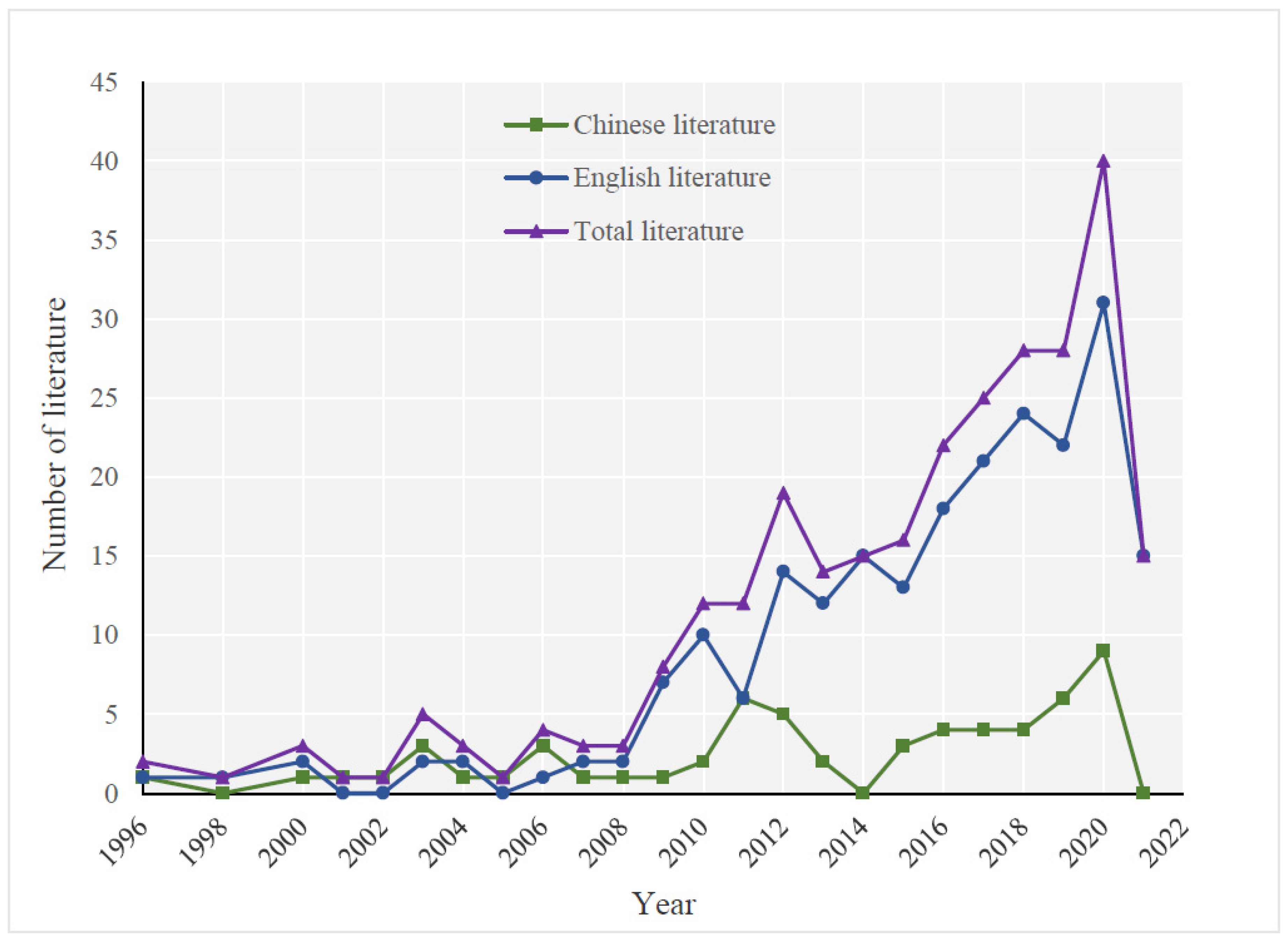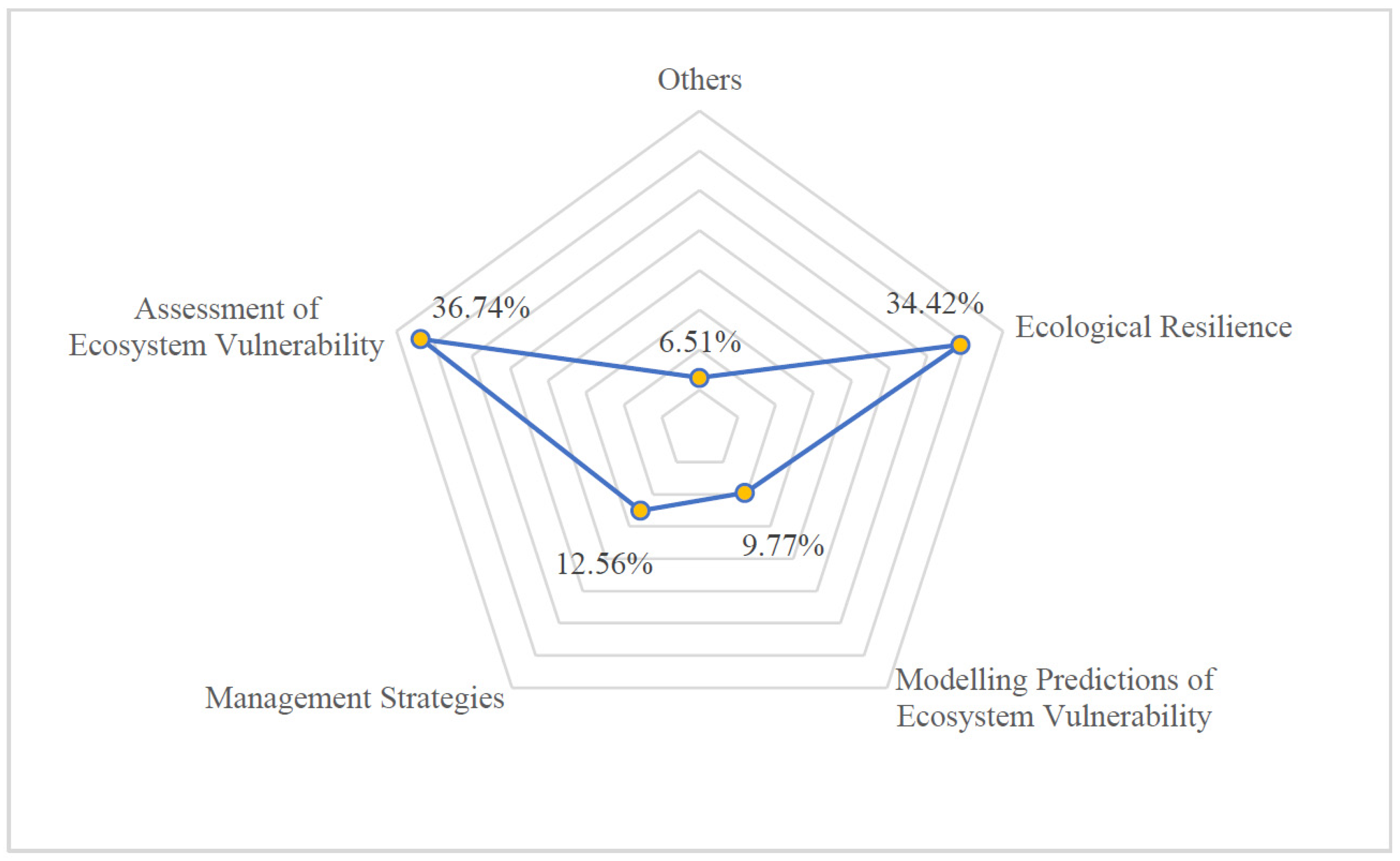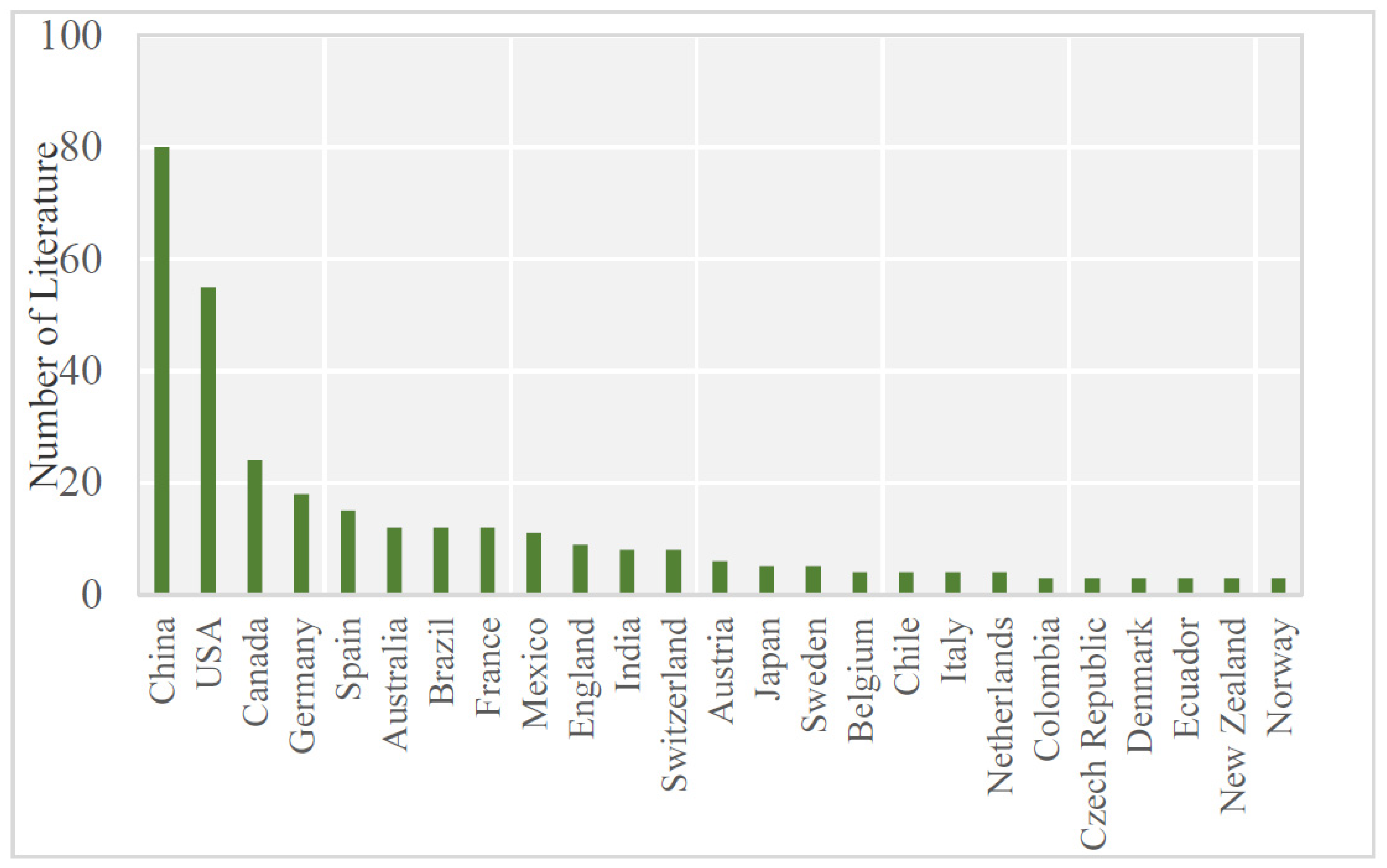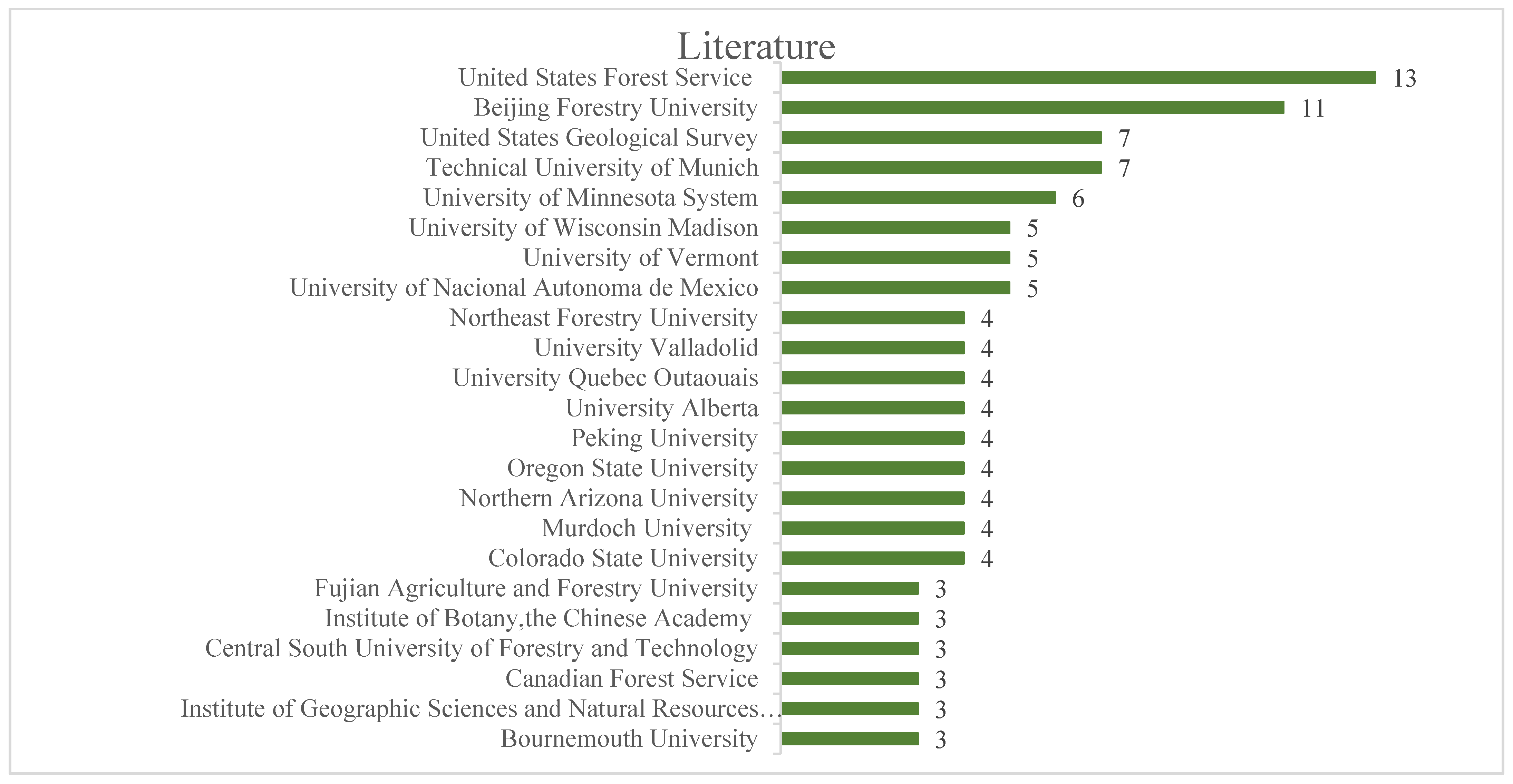A Review of Forest Ecosystem Vulnerability and Resilience: Implications for the Rocky Desertification Control
Abstract
:1. Introduction
2. Acquisition and Argumentation of Literatures
2.1. Annual Distribution of the Literature
2.2. Content Distribution of the Literature
2.3. Country Distribution of the Literature
2.4. Institution Distribution of the Literature
3. Main Progress and Landmark Achievements
3.1. Theoretical Research
3.1.1. The Study of Ecosystem Vulnerability Theory Consists Mainly of the Conceptual Study of Vulnerability, the Analysis of Its Causes, and the Classification of Vulnerability Types
3.1.2. Ecologists Generally Accept That the Concept of Ecological Resilience Includes the Concept of “Engineering and Ecological Resilience”, but There Is No Consensus on How to Define or Apply Resilience in a Forestry Context
3.2. Indicator System
3.2.1. Ecosystem Vulnerability Assessment Indicator System
3.2.2. Ecological Resilience Evaluation Indicator System
3.2.3. Ecosystem Vulnerability-Ecological Resilience Indicator Systems
3.3. Technical Method
3.3.1. Due to the Different Systems of Vulnerability Evaluation Indicators and Data Characteristics, There Are Additionally Many Types of Evaluation Methods, and the Study Needs to Select a Responsive Method for Evaluation According to the Study Scale and the Study Population
3.3.2. Ecological Resilience Characterizes the Resistance and Resilience of a System, so Research Methods Need to Be Temporally and Spatially Specific, Which Additionally Means That Simulation Models Must Follow Principles of Applicability and Innovation
3.3.3. As Ecosystem Vulnerability and Resilience Research Shifts from Mathematical and Theoretical Modelling to “3S” Spatial Analysis, i.e., RS, GIS, and GPS, “3S” Techniques Are Being Used Extensively in the Field of Ecology and the Environment
4. Key Scientific Issues to Be Solved
5. Conclusions and Future Research
Author Contributions
Funding
Institutional Review Board Statement
Informed Consent Statement
Data Availability Statement
Conflicts of Interest
References
- Boonstra, R.; Andreassen, H.P.; Boutin, S.; Hušek, J.; Ims, R.A.; Krebs, C.J.; Skarpe, C.; Wabakken, P. Why do the boreal forest ecosystems of northwestern Europe differ from those of western North America? Bioscience 2016, 66, 722–734. [Google Scholar] [CrossRef]
- Millennium Ecosystem Assessment Board. Ecosystems and Human Well-Being; Island Press: Washington, DC, USA, 2005. [Google Scholar]
- Miyawaki, A. A vegetation-ecological study on regeneration and restoration of vegetation. Veg. Sci. News 2001, 6, 55–62. [Google Scholar]
- Costanza, R.; d’Arge, R.; de Groot, R.; Farber, S.; Grasso, M.; Hannon, B.; Limburg, K.; Naeem, S.; O’Neill, R.V.; Paruelo, J.; et al. The value of the world’s ecosystem services and natural capital. Nature 1997, 387, 253–260. [Google Scholar] [CrossRef]
- Zemp, D.C.; Schleussner, C.-F.; Barbosa, H.M.J.; Rammig, A. Deforestation effects on Amazon forest resilience. Geophys. Res. Lett. 2007, 44, 6182–6190. [Google Scholar] [CrossRef] [Green Version]
- Ozcan, O.; Musaoglu, N.; Tyrkeş, M. Assessing vulnerability of a forest ecosystem to climate change and variability in the western Mediterranean sub-region of Turkey. J. For. Res. 2018, 29, 709–725. [Google Scholar] [CrossRef]
- Akinola, O.V.; Adegoke, J. Assessment of forest fire vulnerability zones in Missouri, United States of America. Int. J. Sustain. Dev. World Ecol. 2019, 26, 251–257. [Google Scholar] [CrossRef]
- Zimmerman, J.K.; Willig, M.R.; Hernandez-Delgado, E.A. Resistance, resilience, and vulnerability of social-ecological systems to hurricanes in Puerto Rico. Ecosphere 2020, 11, e03159. [Google Scholar] [CrossRef]
- Fang, O.; Zhang, Q.B.; Vitasse, Y.; Zweifel, R.; Cherubini, P. The frequency and severity of past droughts shape the drought sensitivity of juniper trees on the Tibetan plateau. For. Ecol. Manag. 2021, 486, 118968. [Google Scholar] [CrossRef]
- Kneeshaw, D.D.; Sturtevant, B.R.; DeGrandpé, L.; Doblas-Miranda, E.; James, P.M.A.; Tardif, D.; Burton, P.J. The Vision of Managing for Pest-Resistant Landscapes: Realistic or Utopic? Curr. For. Rep. 2021, 7, 97–113. [Google Scholar]
- Truman, C.C.; Strickland, T.C.; Potter, T.L.; Franklin, D.H.; Bosch, D.D.; Bednarz, C.W. Variable rainfall intensity and tillage effects on runoff, sediment, and carbon losses from a loamy sand under simulated rainfall. J. Environ. Qual. 2007, 36, 1495–1502. [Google Scholar] [CrossRef] [Green Version]
- Guidi, C.; Di Matteo, G.; Grego, S. An overview of proven Climate Change Vulnerability Assessment tools for forests and forest-dependent communities across the globe: A literature analysis. J. For. Res. 2018, 29, 1167–1175. [Google Scholar] [CrossRef]
- De Lange, H.J.; Sala, S.; Vighi, M.; Faber, J.H. Ecological vulnerability in risk assessment—A review and perspectives. Sci. Total Environ. 2010, 408, 3871–3879. [Google Scholar] [CrossRef] [PubMed]
- Clements, F.E. Research Methods in Ecology; University Publishing Company: Lincoln, NE, USA, 1905. [Google Scholar]
- Niu, W.Y. The discriminatory index with regard to the weakness, overlapness, and breadth of ecotone. Acta Ecol. Sin. 1989, 9, 97–105. [Google Scholar]
- IPCC. Climate Change 2001: Impacts, Adaptation, and Vulnerability; Cambridge University Press: Cambridge, UK; New York, NY, USA, 2001. [Google Scholar]
- Turner, B.L.; Kasperson, R.E.; Matson, P.A.; McCarthy, J.J.; Corell, R.W.; Christensen, L.; Eckley, N.; Kasperson, J.X.; Luers, A.; Martello, M.L.; et al. A framework for vulnerability analysis in sustainability science. Proc. Natl. Acad. Sci. USA 2003, 100, 8074–8079. [Google Scholar] [CrossRef] [Green Version]
- Shao, Y.W.; Xu, J. Understanding urban resilience: A conceptual analysis based on integrated international literature review. Urban Plan. Int. 2015, 30, 48–54. [Google Scholar]
- Holling, C.S. Resilience and Stability of Ecological Systems. Annu. Rev. Ecol. Syst. 1973, 4, 1–23. [Google Scholar] [CrossRef] [Green Version]
- Ouyang, H.; Ye, Q. A review on the evolution of resilient city theory: Concept, context and tendency. City Plan. Rev. 2016, 40, 34–42. [Google Scholar]
- Gunderson, L.H.; Holling, C.S. (Eds.) Panarchy: Understanding Transformations in Human and Natural Systems; Island Press: Washington, DC, USA, 2002. [Google Scholar]
- Liao, K.H. A Theory on Urban Resilience to Floods-A Basis for Alternative Planning Practices. Ecol. Soc. 2012, 17, 48. [Google Scholar] [CrossRef]
- Gann, G.D.; McDonald, T.; Walder, B.; Aronson, J.; Nelson, C.R.; Jonson, J.; Hallett, J.G.; Eisenberg, C.; Guariguata, M.R.; Liu, J.; et al. International Principles and Standards for the Practice of Ecological Restoration. Second edition. Restor. Ecol. 2019, 27, S1–S46. [Google Scholar] [CrossRef] [Green Version]
- Ma, X.Y. Spatial Analysis, Evaluation and Optimization of the Yellow River Beach Area in Xinxiang City from the Perspective of Resilient Cities; Beijing Forestry University: Beijing, China, 2019. [Google Scholar]
- Keenan, R.J. Climate change impacts and adaptation in forest management: A review. Ann. For. Sci. 2015, 72, 145–167. [Google Scholar] [CrossRef] [Green Version]
- Lucier, A.; Ayres, M.; Karnosky, D.; Thompson, I.; Loehle, C.; Percy, K.; Sohngen, B. Forest responses and vulnerabilities to recent climate change. IUFRO World Ser. 2009, 22, 29–52. [Google Scholar]
- De La Serrana, R.G.; Vilagrosa, A.; Alloza, J.A. Pine mortality in southeast Spain after an extreme dry and warm year: Interactions among drought stress, carbohydrates and bark beetle attack. Trees 2015, 29, 1791–1804. [Google Scholar] [CrossRef]
- Bernier, P.; Schoene, D. Adapting Forests and Their Management to Climate Change: An Overiew; Information Service of FAO: Rome, Italy, 2009; Volume 60, pp. 5–11. [Google Scholar]
- Hou, K.; Tao, W.; Wang, L.; Li, X.X. Study on hierarchical transformation mechanisms of regional ecological vulnerability and its applicability. Ecol. Indic. 2020, 114, 106343. [Google Scholar] [CrossRef]
- Nikinmaa, L.; Lindner, M.; Cantarello, E.; Jump, A.S.; Seidl, R.; Winkel, G.; Muys, B. Reviewing the use of resilience concepts in forest sciences. Curr. For. Rep. 2020, 6, 61–80. [Google Scholar] [CrossRef]
- Lecina-Diaz, J.; Martinez-Vilalta, J.; Alvarez, A.; Banque, M.; Birkmann, J.; Feldmeyer, D.; Vayredm, J.; Retana, J. Characterizing forest vulnerability and risk to climate-change hazards. Front. Ecol. Environ. 2021, 19, 126–133. [Google Scholar] [CrossRef]
- Reyer, C.P.O.; Brouwers, N.; Rammig, A.; Brook, B.W.; Epila, J.; Grant, R.F.; Holmgren, M.; Langerwisch, F.; Leuzinger, S.; Lucht, W.; et al. Forest resilience and tipping points at different spatio-temporal scales: Approaches and challenges. J. Ecol. 2015, 103, 5–15. [Google Scholar] [CrossRef] [Green Version]
- Weißhuhn, P.; Müller, F.; Wiggering, H. Ecosystem vulnerability review: Proposal of an interdisciplinary ecosystem assessment approach. Environ. Manag. 2018, 61, 904–915. [Google Scholar] [CrossRef] [Green Version]
- Rana, I.A. Disaster and climate change resilience: A bibliometric analysis. Int. J. Disaster Risk Reduct. 2020, 50, 101839. [Google Scholar] [CrossRef]
- Kumar, M.; Kalra, N.; Singh, H.; Sharma, S.; Singh Rawat, P.; Singh, R.K.; Gupta, A.K.; Jumar, P.; Ravindranath, N.H. Indicator-based vulnerability assessment of forest ecosystem in the Indian Western Himalayas: An analytical hierarchy process integrated approach. Ecol. Indic. 2021, 125, 107568. [Google Scholar] [CrossRef]
- Johnstone, J.F.; Allen, C.D.; Franklin, J.F.; Frelich, L.E.; Harvey, B.J.; Higuera, P.E.; Mack, M.C.; Meentemeyer, R.K.; Metz, M.R.; Perry, G.L.W.; et al. Changing disturbance regimes, ecological memory, and forest resilience. Front. Ecol. Environ. 2016, 14, 369–378. [Google Scholar] [CrossRef]
- Ibarra, J.T.; Cockle, K.; Altamirano, T.; van der Hoek, Y.; Simard, S.W.; Bonacic, C.; Martin, K. Nurturing resilient forest biodiversity: Nest webs as complex adaptive systems. Ecol. Soc. 2020, 25, 27. [Google Scholar] [CrossRef]
- Timmerman, P. Vulnerability, Resilience and the Collapse of Society: A Review of Models and Possible Climatic Applications; Institute for Environmental Studies, University of Toronto: Toronto, ON, Canada, 1981. [Google Scholar]
- Gong, W.; Hu, T.X.; Gong, Y.B. A brief discussion on the formation characteristics of fragile forest ecosystems and their management measures. Sichuan For. Explor. Des. 2004, 3, 5–10. [Google Scholar]
- Schelhaas, M.J.; Hengeveld, G.; Moriondo, M.; Reinds, G.J.; Kundzewicz ter Maat, H.W.; Bindi, M. Assessing risk and adaptation options to fires and windstorms in European forestry. Mitig. Adapt. Strateg. Glob. Chang. 2010, 15, 681–701. [Google Scholar] [CrossRef]
- Mildrexler, D.J.; Yang, Z.; Cohen, W.; Bell, D. A forest vulnerability index based on drought and high temperatures. Remote Sens. Environ. 2016, 173, 314–325. [Google Scholar] [CrossRef] [Green Version]
- Peng, Q.; Lin, C.H.; He, T.F. The development of study on the characteristics of soil and water loss and its conservation in Guizhou karst mountain area. Guizhou Sci. 2006, 24, 66–70. [Google Scholar]
- Ali, A. Climate change impacts and adaptation assessment in Bangladesh. Clim. Res. 1999, 12, 109–116. [Google Scholar] [CrossRef]
- Chuluundorj, O. A Multi-Level Study of Vulnerability of Mongolian Pastoralists to Natural Hazards and Its Consequences on Individual and Household Well-Being; University of Colorado: Denver, CO, USA, 2006. [Google Scholar]
- Bone, C.; Moseley, C.; Vinyeta, K.; Bixler, R.P. Employing resilience in the United States forest service. Land Use Policy 2016, 52, 430–438. [Google Scholar] [CrossRef] [Green Version]
- Pimm, S.L. The complexity and stability of ecosystems. Nature 1984, 307, 321–326. [Google Scholar] [CrossRef]
- Hodgson, D.; McDonald, J.L.; Hosken, D.J. What do you mean, ‘resilient’? Trends Ecol. Evol. 2015, 30, 503–506. [Google Scholar] [CrossRef] [PubMed]
- Thompson, I.; Mackey, B.; McNulty, S.; Mosseler, A. Forest Resilience, Biodiversity and Climate Change: A Synthesis of the Biodiversity/Resilience/Stability Relationship in Forest Ecosystems; Technical Series no. 43; Secretariat of the Convention on Biological Diversity: Montreal, QC, Canada, 2009; pp. 1–67. [Google Scholar]
- Law, B.E.; Waring, R.H. Carbon implications of current and future effects of drought, fire and management on Pacific Northwest forests. For. Ecol. Manag. 2015, 355, 4–14. [Google Scholar] [CrossRef] [Green Version]
- Huang, M.; Wang, X.; Keenan, T.F.; Piao, S. Drought timing influences the legacy of tree growth recovery. Glob. Chang. Biol. 2018, 24, 3546–3559. [Google Scholar] [CrossRef] [Green Version]
- Brown, E.D.; Williams, B.K. Resilience and resource management. Environ. Manag. 2018, 56, 1416–1427. [Google Scholar] [CrossRef] [PubMed] [Green Version]
- Yu, B.H.; Lu, C.H. Assessment of ecological vulnerability on the Tibetan plateau. Geogr. Res. 2011, 30, 2289–2295. [Google Scholar]
- Berger, A.R.; Hodge, R.A. Natural change in the environment: A challenge to the pressure-state-response concept. Soc. Indic. Res. 1998, 44, 255–265. [Google Scholar] [CrossRef]
- Polsky, C.; Neff, R.; Yarnal, B. Building comparable global change vulnerability assessments:The vulnerability scoping diagram. Glob. Environ. Chang. Hum. Policy Dimens. 2007, 17, 472–485. [Google Scholar] [CrossRef]
- Cinco-Castro, S.; Herrera-Silveira, J. Vulnerability of mangrove ecosystems to climate change effects: The case of the Yucatan Peninsula. Ocean Coast. Manag. 2020, 192, 105196. [Google Scholar] [CrossRef]
- Wang, J.Y.; Zhao, G.X.; Wang, X.F.; Wang, L.H.; Liu, M.S.; Liu, T. On the vulnerability of China’s ecological environment and its assessment. Shandong Agric. Sci. 2004, 2, 9–11. [Google Scholar]
- Xu, G.C.; Kang, M.Y.; He, L.N.; Li, Y.F.; Chen, Y.R. Advance in research on ecological vulnerability. Acta Ecol. Sin. 2009, 29, 2578–2588. [Google Scholar]
- Turkes, M.; Musaoglu, N.; Ozcan, O. Assessing the vulnerability of a forest ecosystem to climate change and variability in the western Mediterranean sub-region of Turkey: Future Evaluation. J. For. Res. 2018, 29, 1177–1186. [Google Scholar] [CrossRef]
- Derroire, G.; Balvanera, P.; Castellanos-Castro, C.; Decocq, G.; Kennard, D.K.; Lebrija-Trejos, E.; Leiva, J.A.; Oden, P.-C.; Powers, J.S.; Rico-Gray, V.; et al. Resilience of tropical dry forests–a meta-analysis of changes in species diversity and composition during secondary succession. Oikos 2016, 125, 1386–1397. [Google Scholar] [CrossRef] [Green Version]
- Lennox, G.D.; Gardner, T.A.; Thomson, J.R.; Ferreira, J.; Berenguer, E.; Lees, A.C.; Nally, R.M.; Aragao, L.E.O.C.; Ferraz, S.F.B.; Louzada, J.; et al. Second rate or a second chance? Assessing biomass and biodiversity recovery in regenerating Amazonian forests. Glob. Chang. Biol. 2018, 24, 5680–5694. [Google Scholar] [CrossRef] [PubMed] [Green Version]
- Folke, C.; Carpenter, S.; Walker, B.; Scheffer, M. Regime shifts, resilience, and biodiversity in ecosystem management. Annu. Rev. Ecol. Evol. Syst. 2004, 35, 557–581. [Google Scholar] [CrossRef] [Green Version]
- Craven, D.; Filotas, E.; Angers, V.A.; Messier, C. Evaluating resilience of tree communities in fragmented landscapes: Linking functional response diversity with landscape connectivity. Divers. Distrib. 2016, 22, 505–518. [Google Scholar] [CrossRef]
- López-Jiménez, L.N.; Duran-Garcia, R.; Dupuy-Rada, J.M. Recovery of structure, diversity and composition of a tropical semievergreen forest in Yucatan, Mexico. Madera Bosques 2019, 25, e2511587. [Google Scholar]
- Rivera-Monroy, V.H.; Danielson, T.M.; Castañeda-Moya, E.; Marx, B.D.; Travieso, R.; Zhao, X.; Gaiser, E.E.; Farfan, L.M. Long-term demography and stem productivity of Everglades mangrove forests (Florida, USA): Resistance to hurricane disturbance. For. Ecol. Manag. 2019, 440, 79–91. [Google Scholar] [CrossRef]
- IPCC. Climate Change 2014: Impacts, Adaptation, and Vulnerability; Cambridge University Press: Cambridge, UK, 2014. [Google Scholar]
- Angeler, D.G.; Baho, D.L.; Allen, C.R.; Johnson, R.K. Linking degradation status with ecosystem vulnerability to environmental change. Oecologia 2015, 178, 899–913. [Google Scholar] [CrossRef] [PubMed] [Green Version]
- Cui, X.; Gibbes, C.; Southworth, J.; Waylen, P. Using remote sensing to quantify vegetation change and ecological resilience in a semi-arid system. Land 2013, 2, 108–130. [Google Scholar] [CrossRef] [Green Version]
- Dwomoh, F.K.; Wimberly, M.C. Fire regimes and forest resilience: Alternative vegetation states in the West African tropics. Landsc. Ecol. 2017, 32, 1849–1865. [Google Scholar] [CrossRef]
- Li, J.D.; Xu, D. Evaluation on exploitation potential of forest health tourism based on AHP and fuzzy synthetic evaluation-A case study of Liaodong mountain area. Chin. J. Agric. Resour. Reg. Plan. 2018, 39, 135–142. [Google Scholar]
- Giglio, E. Landscape ecological method to study agriculture vegetation: Some examples from the po valley. Ann. Bot. 2016, 6, 95–110. [Google Scholar]
- Delgado, A.; Vidal, J.; Castro, J.; Felix, J.; Saenz, J. Assessment of Surface Water Quality on the Upper Watershed of Huallaga River, in Peru, using Grey Systems and Shannon Entropy. Int. J. Adv. Comput. Sci. Appl. 2020, 11, 437–444. [Google Scholar] [CrossRef]
- Xenarios, S.; Nemes, A.; Sarker, G.W.; Nagothu, U.S. Assessing vulnerability to climate change: Are communities in flood-prone areas in Bangladesh more vulnerable than those in drought-prone areas? Water Resour. Rural Dev. 2016, 7, 1–19. [Google Scholar] [CrossRef]
- Li, B.; Yang, Z.; Su, F. Vulnerability measurement of Chinese marine economic system based on set pair analysis. Sci. Geogr. Sin. 2016, 36, 47–54. [Google Scholar]
- Wirehn, L.; Danielsson, A.; Neset, T.-S.S. Assessment of composite index methods for agricultural vulnerability to climate change. J. Environ. Manag. 2015, 156, 70–80. [Google Scholar] [CrossRef]
- Huang, Z.; Wan, J. Vulnerability assessment of safe operation of utility tunnel based on improved matter-element extension method. Constr. Sci. Technol. 2020, 8, 78–81. [Google Scholar]
- Standish, R.J.; Hobbs, R.J.; Mayfield, M.M.; Bestelmeyer, B.; Suding, K.N.; Battaglia, L.; Eviner, V.T.; Hawkes, C.V.; Temperton, V.M.; Harris, V.A.C.J. Resilience in ecology: Abstraction, distraction, or where the action is? Biol. Conserv. 2014, 177, 43–51. [Google Scholar] [CrossRef] [Green Version]
- Carpenter, S.R.; Westley, F.; Turner, M.G. Surrogates for resilience of social–ecological systems. Ecosystems 2005, 8, 941–944. [Google Scholar] [CrossRef]
- Nemec, K.T.; Chan, J.; Hoffman, C.; Spanbauer, T.L.; Hamm, J.A.; Allen, C.R.; Hefley, T.; Pan, D.; Shrestha, P. Assessing resilience in stressed watersheds. Ecol. Soc. 2014, 19, 34. [Google Scholar] [CrossRef] [Green Version]
- Behera, M.D.; Murthy, M.S.R.; Das, P.; Sharma, E. Modelling forest resilience in Hindu Kush Himalaya using geoinformation. J. Earth Syst. Sci. 2018, 127, 95. [Google Scholar] [CrossRef] [Green Version]
- Duveneck, M.J.; Scheller, R.M. Measuring and managing resistance and resilience under climate change in northern Great Lake forests (USA). Landsc. Ecol. 2016, 31, 669–686. [Google Scholar] [CrossRef]
- Cantarello, E.; Newton, A.C.; Martin, P.A.; Evans, P.M.; Gosal, A.; Lucash, M.S. Quantifying resilience of multiple ecosystem services and biodiversity in a temperate forest landscape. Ecol. Evol. 2017, 7, 9661–9675. [Google Scholar] [CrossRef] [PubMed] [Green Version]
- Zhang, X.L.; Yu, W.B.; Cai, H.S.; Guo, X.M. Review of the evaluation methods of regional eco-environmental vulnerability. Acta Ecol. Sin. 2018, 38, 5970–5981. [Google Scholar]
- Fang, C.; Wang, Y.; Fang, J. A comprehensive assessment of urban vulnerability and its spatial differentiation in China. J. Geogr. Sci. 2016, 26, 153–170. [Google Scholar] [CrossRef]
- Sahana, M.; Ganaie, T.A. GIS-based landscape vulnerability assessment to forest fire susceptibility of Rudraprayag district, Uttarakhand, India. Environ. Earth Sci. 2017, 76, 676. [Google Scholar] [CrossRef]
- Hart, S.J.; Henkelman, J.; McLoughlin, P.D.; Nielsen, S.E.; Truchon-Savard, A.; Johnstone, J.F. Examining forest resilience to changing fire frequency in a fire-prone region of boreal forest. Glob. Chang. Biol. 2019, 25, 869–884. [Google Scholar] [CrossRef]
- Perie, C.; de Blois, S. Dominant forest tree species are potentially vulnerable to climate change over large portions of their range even at high latitudes. Peer J. 2016, 4, e2218. [Google Scholar] [CrossRef] [Green Version]
- Seidl, R.; Spies, T.A.; Peterson, D.L.; Stephens, S.L.; Hicke, J.A. Searching for resilience: Addressing the impacts of changing disturbance regimes on forest ecosystem services. J. Appl. Ecol. 2016, 53, 120–129. [Google Scholar] [CrossRef] [Green Version]
- Wang, C.J.; Zhang, Z.X.; Wan, J.Z. Vulnerability of global forest ecoregions to future climate change. Glob. Ecol. Conserv. 2019, 20, e00760. [Google Scholar] [CrossRef]
- Bourgoin, C.; Oszwald, J.; Bourgoin, J.; Gond, V.; Blanc, L.; Dessard, H.; Van Phan, T.; Sist, P.; Laderach, P.; Reymondin, L. Assessing the ecological vulnerability of forest landscape to agricultural frontier expansion in the Central Highlands of Vietnam. Int. J. Appl. Earth Obs. Geoinf. 2020, 84, 101958. [Google Scholar] [CrossRef]
- Prentice, I.C.; Cramer, W.; Harrison, S.P.; Leemans, R.; Monserud, R.A.; Solomon, A.M. A global biome model based on plant physiology and dominance, soil properties and climate. J. Biogeogr. 1992, 19, 117–134. [Google Scholar] [CrossRef]
- Guo, B.; Zang, W.; Luo, W. Spatial-temporal shifts of ecological vulnerability of Karst Mountain ecosystem-impacts of global change and anthropogenic interference. Sci. Total Environ. 2020, 741, 140256. [Google Scholar] [CrossRef]
- Hu, W.J.; Chen, B.; Arnupap, P.; Zhang, D.; Liu, X.M.; Gu, H.F.; Ajcharaporn, P.; Chao, B.X.; Zheng, X.Q. Ecological vulnerability assessment of coral reef: A case study of Si Chang island, Thailand. Chin. J. Ecol. 2020, 39, 979–989. [Google Scholar]
- Albrich, K.; Rammer, W.; Turner, M.G.; Ratajczak, Z.; Brazinuas, K.H.; Hansen, W.D.; Seidl, R. Simulating forest resilience: A review. Glob. Ecol. Biogeogr. 2020, 29, 2082–2096. [Google Scholar] [CrossRef] [PubMed]
- Liu, M.; Liu, X.; Wu, L.; Tang, Y.; Li, Y.; Zhang, Y.; Ye, L.; Zhang, B. Establishing forest resilience indicators in the hilly red soil region of southern China from vegetation greenness and landscape metrics using dense Landsat time series. Ecol. Indic. 2021, 121, 106985. [Google Scholar] [CrossRef]
- Gao, S.; Liu, R.; Zhou, T.; Fang, W.; Yi, C.; Lu, R.; Luo, H. Dynamic responses of tree-ring growth to multiple dimensions of drought. Glob. Chang. Biol. 2018, 24, 5380–5390. [Google Scholar] [CrossRef] [Green Version]
- Di Mauro, B.; Fava, F.; Busetto, L.; Crosta, G.F.; Colombo, R. Post-fire resilience in the Alpine region estimated from MODIS satellite multispectral data. Int. J. Appl. Earth Obs. Geoinf. 2014, 32, 163–172. [Google Scholar] [CrossRef]
- Spasojevic, M.J.; Bahlai, C.A.; Bradley, B.A.; Butterfield, B.J.; Tuanmu, M.N.; Sistla, S.; Suding, K.N. Scaling up the diversity–resilience relationship with trait databases and remote sensing data: The recovery of productivity after wildfire. Glob. Chang. Biol. 2016, 22, 1421–1432. [Google Scholar] [CrossRef] [Green Version]
- Danielson, T.M.; Rivera-Monroy, V.H.; Castañeda-Moya, E.; Briceño, H.; Travieso, R.; Marx, B.D.; Farfán, L.M. Assessment of Everglades mangrove forest resilience: Implications for above-ground net primary productivity and carbon dynamics. For. Ecol. Manag. 2017, 404, 115–125. [Google Scholar] [CrossRef]
- Wu, X.; Zhang, J.; Geng, X.; Wang, T.; Wang, K.; Liu, S. Increasing green infrastructure-based ecological resilience in urban systems: A perspective from locating ecological and disturbance sources in a resource-based city. Sustain. Cities Soc. 2020, 61, 102354. [Google Scholar] [CrossRef]
- IUCN. Ecosystem-Based Adaptation: An Approach for Building Resilience and Reducing Risk for Local Communities and Ecosystems. Submission to the Chair of the AWG-LCA with respect to the Shared Vision and Enhanced Action on Adaptation; International Union for the Conservation of Nature: Grand, Switzerland, 2008. [Google Scholar]
- Yang, M.D. On the fragility of karst environment. Yunnan Geogr. Environ. Res. 1990, 2, 21–29. [Google Scholar]
- Ouyang, Z.Y. On the comprehensive management, development and breaking away from poorness of the ecologically fragile karst area in south-west China. World Sci.-Tech. R. D. 1998, 2, 3–5. [Google Scholar]
- Xiong, K.N.; Li, P.; Zhou, Z.F. A Typical Study on Remote Sensing-GIS of Karst Desertification in Guizhou Province; Geological Publishing House: Beijing, China, 2002; pp. 128–150. [Google Scholar]
- Xiong, K.N.; Mei, Z.M.; Peng, X.W.; Lan, A.J. Integrated management of the karst rock desertification areas—A case study of Huangjiang karst gorge. Guizhou For. Sci. Technol. 2006, 1, 5–8. [Google Scholar]
- Yang, M.D. On the geographical structure of karst landscapes and their environmental effects. Guizhou Soc. Environ. Sci. 1998, 11, e03159. [Google Scholar]




Publisher’s Note: MDPI stays neutral with regard to jurisdictional claims in published maps and institutional affiliations. |
© 2021 by the authors. Licensee MDPI, Basel, Switzerland. This article is an open access article distributed under the terms and conditions of the Creative Commons Attribution (CC BY) license (https://creativecommons.org/licenses/by/4.0/).
Share and Cite
Liu, H.; Xiong, K.; Yu, Y.; Li, T.; Qing, Y.; Wang, Z.; Zhang, S. A Review of Forest Ecosystem Vulnerability and Resilience: Implications for the Rocky Desertification Control. Sustainability 2021, 13, 11849. https://doi.org/10.3390/su132111849
Liu H, Xiong K, Yu Y, Li T, Qing Y, Wang Z, Zhang S. A Review of Forest Ecosystem Vulnerability and Resilience: Implications for the Rocky Desertification Control. Sustainability. 2021; 13(21):11849. https://doi.org/10.3390/su132111849
Chicago/Turabian StyleLiu, Haiyan, Kangning Xiong, Yanghua Yu, Tingling Li, Yao Qing, Zhifu Wang, and Shihao Zhang. 2021. "A Review of Forest Ecosystem Vulnerability and Resilience: Implications for the Rocky Desertification Control" Sustainability 13, no. 21: 11849. https://doi.org/10.3390/su132111849
APA StyleLiu, H., Xiong, K., Yu, Y., Li, T., Qing, Y., Wang, Z., & Zhang, S. (2021). A Review of Forest Ecosystem Vulnerability and Resilience: Implications for the Rocky Desertification Control. Sustainability, 13(21), 11849. https://doi.org/10.3390/su132111849





